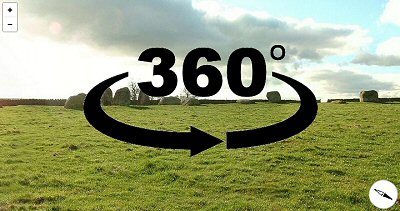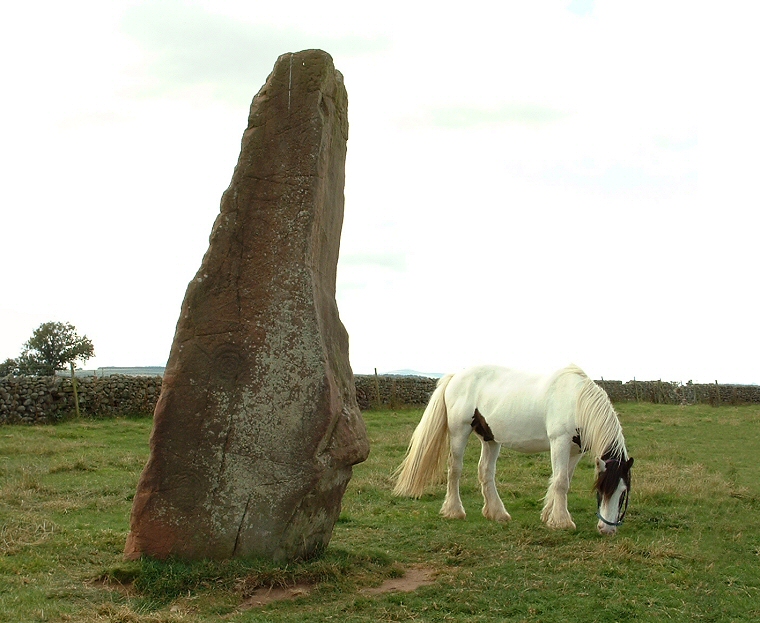 |
|
Situated
on a gently eastwards sloping hillside
with the western foothills of Pennines as a dramatic backdrop, the site known as Long Meg and her Daughters is the largest
stone
circle in Cumbria and the sixth largest in England - it is also thought to be one of the earliest,
dating from the late Neolithic
or the early Bronze
Age. Upon visiting the site the poet William Wordsworth was so impressed he penned the following
'I must say, I have not seen any other relique of those dark ages which can pretend to rival it in singularity and dignity of appearance'. 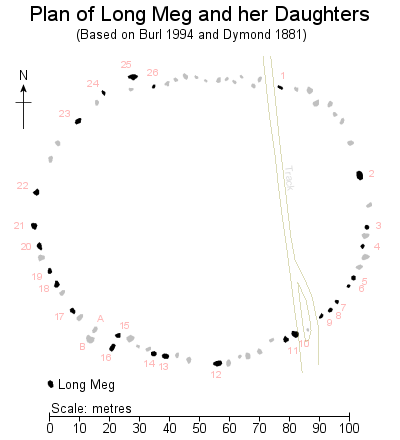 The eponymous Long Meg herself is a huge red sandstone pillar standing some 3.6 metres above ground level and estimated to weigh in the region of 9 tones, the obliging horse in the photograph
above gives some indication of the size and bulk of the monolith. She stands 22 metres southwest of the stone circle referred to as the Daughters. The eponymous Long Meg herself is a huge red sandstone pillar standing some 3.6 metres above ground level and estimated to weigh in the region of 9 tones, the obliging horse in the photograph
above gives some indication of the size and bulk of the monolith. She stands 22 metres southwest of the stone circle referred to as the Daughters. The two sides of Long Meg that face away from the the circle appear to have have been smoothed while on the side that faces roughly towards the circle (the left hand face in the photo) there are a series of rock carvings consisting of spirals and concentric circles, rings and grooves. These are shown in detail in the last four picture in the series of clickable thumbnails below. In the black and white drawings based on rock-art expert Stan Beckensall's plan of the markings I have shown the more prominent carvings in black and the more faded designs in grey. Some of the markings towards the top of the stone appear to be more abstract geometric shapes, although which might be considered to be man-made and which may be natural features of the stone is difficult to interpret. The distinction may not have mattered to the people who decorated the stone. It is thought that Long Meg may have been brought from somewhere close to the River Eden which is located just over half a mile (1km) to the west and it is possible that she was cut from a rock outcrop that already held pre-existing rock carvings although other carvings may have been added after she had been positioned in her final resting place. A different type of rock was used for the stones of the circle and what remains on site today consists of sixty-nine granite glacial erratics, some standing, some fallen, others being boulders that may never have been intended to stand upright, arranged in an rough oval but flattened along the northern edge and measuring about 94 metres north to south and 109 metres east to west. A presumed entrance to the southwest is flanked by a pair of stones located just outside the circle (Stones 15, 16, A, B on the plan above, standing stones marked black, fallen stones grey) with Long Meg beyond but interestingly this entrance does not align with Long Meg which is offset slightly further to the west (see third thumbnail below), nor does the entrance align with the centre of the circle although given the irregular layout of the stones it is difficult to pinpoint exactly where this centre might be. It is also said that Long Meg herself aligns with the midwinter sunset when viewed from this putative 'centre', which may suggest that the entrance and the standing stone served different purposes or were constructed at different times. This brings us to the question of the sequence of monument building at the site. In recent years evidence of a massive ditched enclosure has been discovered to the north of the circle and this may explain the slightly flattened northern section, namely that the builders of the stone circle were respecting an existing earlier earthwork. Another possible enclosure was located about 150 metres to the east of the circle while yet another stood 300 metres to the northwest and may also have been related to the circle, however both are undated. To the southwest of the circle aerial photography has revealed the existence of a series of buried ditches that could be a Neolithic cursus, a type of monument previously unknown of in Cumbria. Long Meg stands towards the eastern end of this earthwork and if it was indeed a cursus the stone may have marked the terminus of a processional route that may have predated the circle. The antiquarian William Stukeley recorded another smaller stone circle 200 metres to the southwest in 1725, this has sadly now been destroyed but could have been a later monument than those at Long Meg. There are also antiquarian reports of a pair of cairns inside the Daughters circle although these are of unknown date and may also be a later addition to the site. It is clear that the area was a focus of much activity in prehistory although the exact the exact chronology of the monuments still eludes us. Like many other prehistoric sites Long Meg has attracted it's share of myths and legends over the centuries. One common piece of folklore is that the stones are uncountable, another is that the site is a coven of witches turned to stone for dancing on the Sabbath while yet another proposes that the stones of the circle are in fact Long Meg's lovers, although similarly their fate was to be turned to stone. Wordsworth also wondered on the origin of Long Meg - A weight of Awe not easy to be bourne Fell suddenly upon my spirit, cast From the dread bosom of the unknown past, When first I saw that family forlorn . . . . . . . . Speak Thou, whose massy strength and stature scorn The power of the years - pre-eminent, and placed Apart, to overlook the circle vast Speak, Giant-mother! tell it to the Morn Close by are two round cairns that also feature carved stones. Little Meg just over 600 metres to the east-northeast and Glassonby about 2 km to the north. |
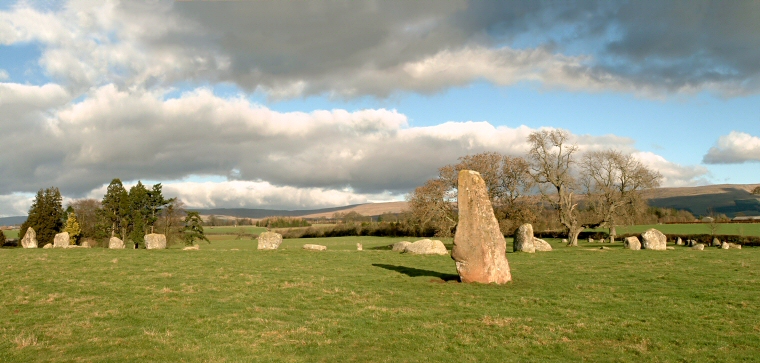 View of Long Meg with the Daughters stone circle beyond. Looking northeast, Feb 2004. |
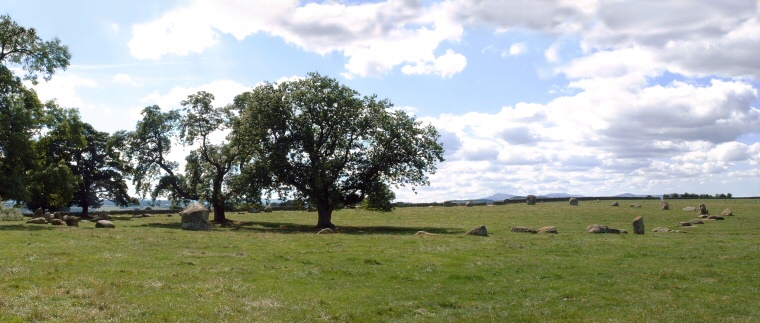 Looking southwest with Long Meg hidden behind the branches of the right hand tree. August 2003. |
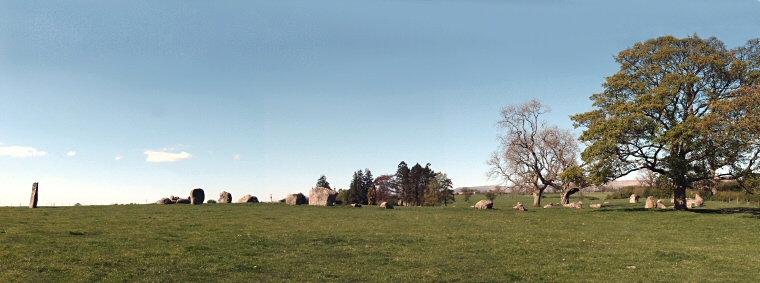 Looking northwest, Long Meg is to the far left, the circle is to the right. May 2002. |
 Looking south with the circle in the foreground, Long Meg is on the horizon to the right. August 1994. |
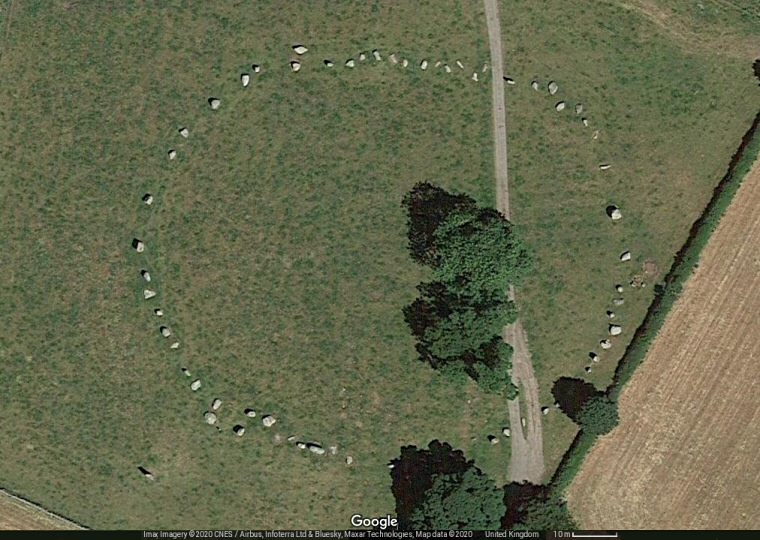 Satellite image of the stone circle with Long Meg standing towards the bottom left of image. |
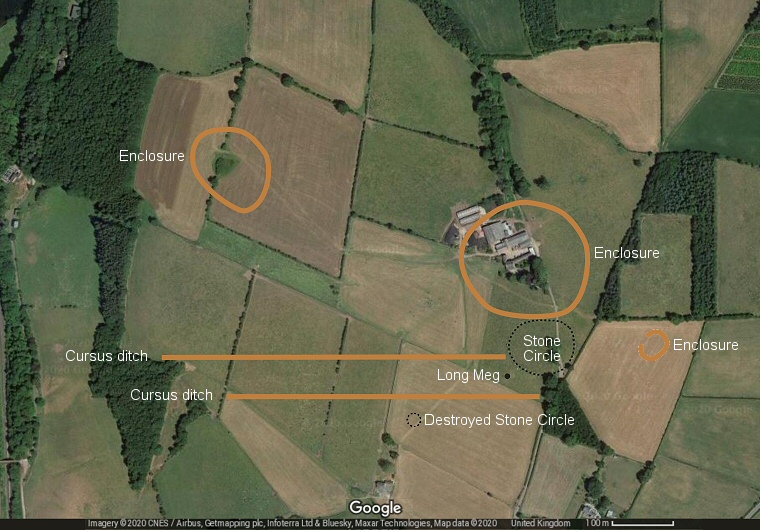 Plan of the prehistoric landscape features around Long Meg and her Daughters. |
Site Visits / Photographs: August 1994, May 2002, August 2003, December 2003, February 2004. References: Barnatt, J. 1987. The Design and Distribution of Stone Circles in Britain... Thesis, (PhD). University of Sheffield. Barrowclough, D. 2010. Prehistoric Cumbria. Stroud: The History Press. Beckensall, S. 1999. British Prehistoric Rock Art. Stroud: Tempus Publishing Ltd. Beckensall, S. 2002. Prehistoric Rock Art in Cumbria. Stroud: Tempus Publishing Ltd. Bradley, R. 1993. Altering the Earth. Soc. Antiquaries of Scotland Monograph 8. Stroud: Sutton. Burl, A. 1976. The Stone Circles of the British Isles. London: Yale University Press. Burl, A. 1979. Rings of Stone. London: Frances Lincoln Publishers Ltd. Burl, A. 1994. The stone circle of Long Meg and Her Daughters.... TCWAAS. Series 2, Vol 94, 1-11. Burl, A. 1995. A Guide to the Stone Circles of Britain, Ireland and Brittany. London: Yale University Press. Camden, W. 1722. Britannia. Gibson Edition Vol 1. London: Clare, T. 2007. Prehistoric Monuments of the Lake District. Stroud: Tempus Publishing Ltd. Cope, J. 1998. The Modern Antiquarian. A Pre-Millennial Odyssey through Megalithic Britain. London: Thorsons. Dymond, C. 1881. A Group of Cumberland Megaliths. TCWAAS, Series 1, Vol 5, 39-57. English Heritage. Extract from English Heritage's record of scheduled monuments. NMR: 23663. Farrah, R. 2008. A Guide to the Stone Circles of Cumbria. Kirkby Stephen: Hayloft Publishing Ltd. Fiennes, C. 1888. Through England on a Side Saddle in the time of William and Mary. London: Hutchinson, W. 1774. An Excursion to the Lakes...August 1773. London: Wilkie & Goldsmith. Hutchinson, W 1794. The History of the County of Cumberland. London: Jollie. Stukeley, W. 1776. Itinerarium Curiosum. Centuria II. London: Baker & Leigh. Thom, A. 1967. Megalithic Sites in Britain. London: Oxford University Press. Wilkinson, J. 1860. ...some British Remains in England. Journal Brit. Arch. Assoc., 16, 101-132. Wordsworth, W. 1822. The monument commonly called Long Meg. Online BBC. TCWAAS = Transactions of the Cumberland and Westmorland Antiquarian and Archaeological Society. |












